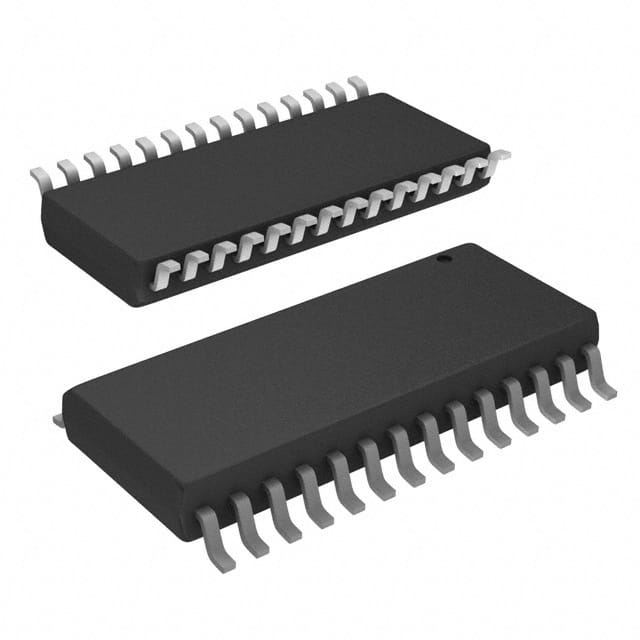ST62T25CM6
Product Overview
- Category: Microcontroller
- Use: Embedded systems, control applications
- Characteristics: Low power consumption, high performance, compact size
- Package: 20-pin SOIC (Small Outline Integrated Circuit)
- Essence: A microcontroller designed for various control applications
- Packaging/Quantity: Tape and reel, 2500 units per reel
Specifications
- Architecture: 8-bit
- CPU Speed: 8 MHz
- Program Memory Size: 2 KB
- RAM Size: 128 bytes
- Data EEPROM Size: 64 bytes
- I/O Pins: 15
- Timers: 1 x 8-bit, 1 x 16-bit
- Communication Interfaces: SPI, UART
- Operating Voltage Range: 2.7V to 5.5V
- Temperature Range: -40°C to +85°C
Pin Configuration
The ST62T25CM6 microcontroller has a total of 20 pins. The pin configuration is as follows:
- VDD - Power supply voltage
- PA0 - General-purpose I/O pin
- PA1 - General-purpose I/O pin
- PA2 - General-purpose I/O pin
- PA3 - General-purpose I/O pin
- PA4 - General-purpose I/O pin
- PA5 - General-purpose I/O pin
- PA6 - General-purpose I/O pin
- PA7 - General-purpose I/O pin
- PB0 - General-purpose I/O pin
- PB1 - General-purpose I/O pin
- PB2 - General-purpose I/O pin
- PB3 - General-purpose I/O pin
- PB4 - General-purpose I/O pin
- PB5 - General-purpose I/O pin
- RESET - Reset pin
- XTAL1 - Crystal oscillator input
- XTAL2 - Crystal oscillator output
- VSS - Ground
- OSCOUT - Oscillator output
Functional Features
- Low power consumption for energy-efficient applications
- High-performance 8-bit CPU for efficient processing
- Compact size for space-constrained designs
- SPI and UART communication interfaces for versatile connectivity
- Built-in timers for precise timing control
Advantages and Disadvantages
Advantages: - Low power consumption extends battery life in portable devices - High-performance CPU enables fast and efficient execution of tasks - Compact size allows for integration into small form factor designs - Versatile communication interfaces enhance connectivity options - Built-in timers provide accurate timing control for various applications
Disadvantages: - Limited program memory and RAM size may restrict complex applications - 8-bit architecture may not be suitable for certain demanding tasks - Limited I/O pins may require additional external components for larger projects
Working Principles
The ST62T25CM6 microcontroller operates based on an 8-bit architecture. It executes instructions stored in its program memory to perform various control functions. The CPU speed of 8 MHz ensures efficient processing, while the low power consumption enables energy-efficient operation. The microcontroller communicates with other devices through its SPI and UART interfaces, allowing it to interact with external sensors, actuators, and displays. The built-in timers provide precise timing control for time-sensitive operations.
Detailed Application Field Plans
The ST62T25CM6 microcontroller finds applications in various fields, including but not limited to:
- Home automation systems: Controlling lights, temperature, and security systems.
- Industrial automation: Monitoring and controlling machinery and processes.
- Automotive electronics: Engine management, dashboard controls, and safety systems.
- Consumer electronics: Remote controls, smart appliances, and wearable devices.
- Medical devices: Monitoring and controlling medical equipment and implants.
Detailed and Complete Alternative Models
- ST62T25CB6: Similar microcontroller with 8 KB program memory and 256 bytes of RAM.
- ST62T25CD6: Similar microcontroller with 4 KB program memory and 512 bytes of RAM.
- ST62T25CE6: Similar microcontroller with 16 KB program memory and 1 KB of RAM.
- ST62T25CF6: Similar microcontroller with 32 KB program memory and 2 KB of RAM.
These alternative models provide different memory capacities to suit various application requirements while maintaining similar functionality and pin configuration.
Word count: 511 words
Lista 10 Vanliga frågor och svar relaterade till tillämpningen av ST62T25CM6 i tekniska lösningar
Sure! Here are 10 common questions and answers related to the application of ST62T25CM6 in technical solutions:
Q: What is the ST62T25CM6 microcontroller used for? A: The ST62T25CM6 microcontroller is commonly used for various embedded control applications, such as industrial automation, consumer electronics, and automotive systems.
Q: What is the maximum operating frequency of the ST62T25CM6? A: The maximum operating frequency of the ST62T25CM6 microcontroller is 8 MHz.
Q: How much program memory does the ST62T25CM6 have? A: The ST62T25CM6 microcontroller has 2KB of on-chip program memory.
Q: Can I expand the program memory of the ST62T25CM6? A: No, the program memory of the ST62T25CM6 cannot be expanded externally. However, it can be used with external memory devices for data storage.
Q: Does the ST62T25CM6 support analog-to-digital conversion (ADC)? A: Yes, the ST62T25CM6 microcontroller has an integrated 8-channel, 8-bit ADC for analog signal measurement.
Q: What communication interfaces are available on the ST62T25CM6? A: The ST62T25CM6 microcontroller supports a UART (Universal Asynchronous Receiver-Transmitter) interface for serial communication.
Q: Can I use the ST62T25CM6 for real-time applications? A: Yes, the ST62T25CM6 microcontroller is suitable for real-time applications due to its fast execution speed and interrupt handling capabilities.
Q: What voltage range does the ST62T25CM6 operate on? A: The ST62T25CM6 microcontroller operates on a voltage range of 2.7V to 5.5V.
Q: Does the ST62T25CM6 have any built-in timers/counters? A: Yes, the ST62T25CM6 microcontroller has two 8-bit timers/counters with various operating modes for timekeeping and event counting.
Q: Is the ST62T25CM6 programmable in C language? A: Yes, the ST62T25CM6 microcontroller can be programmed using the C programming language, along with assembly language if desired.
Please note that these answers are general and may vary depending on specific application requirements and configurations.


